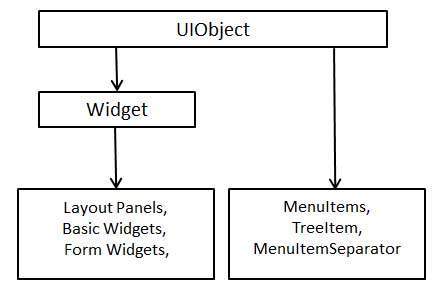GWT - Basic Widgets
Every user interface considers the following three main aspects:
- UI elements : Thes are the core visual elements the user eventually sees and interacts with. GWT provides a huge list of widely used and common elements varying from basic to complex which we will cover in this tutorial.
- Layouts: They define how UI elements should be organized on the screen and provide a final look and feel to the GUI (Graphical User Interface). This part will be covered in Layout chapter.
- Behavior: These are events which occur when the user interacts with UI elements. This part will be covered in Event Handling chapter.
GWT UI Elements:
The GWT library provides classes in a well-defined class hierarchy to create complex web-based user interfaces. All classes in this component hierarchy has been derived from theUIObject base class as shown below:

Every Basic UI widget inherits properties from Widget class which in turn inherits properties from UIObject. Tree and Menu will be covered in complex widgets tutorial.
| S.N. | Widget & Description |
|---|---|
| 1 |
This widget contains text, not interpreted as HTML using a <div>element, causing it to be displayed with block layout.
|
| 2 |
This widget can contain HTML text and displays the html content using a <div> element, causing it to be displayed with block layout.
|
Basic Widgets
Following are few important Basic Widgets:
| S.N. | Widget & Description |
|---|---|
| 1 |
This widget contains text, not interpreted as HTML using a <div>element, causing it to be displayed with block layout.
|
| 2 |
This widget can contain HTML text and displays the html content using a <div> element, causing it to be displayed with block layout.
|
| 3 |
This widget displays an image at a given URL.
|
| 4 |
This widget represents a simple <a> element.
|






